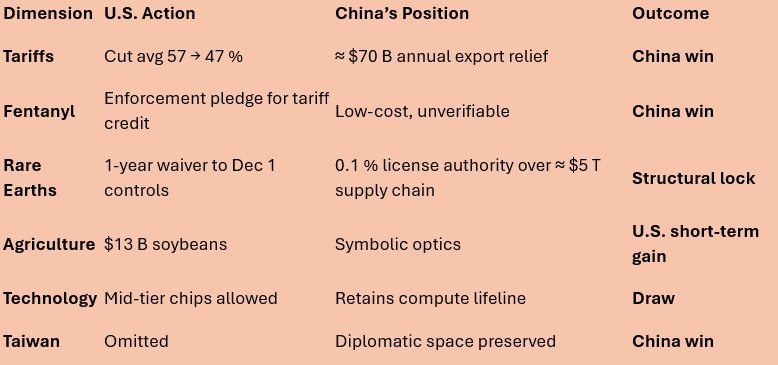Trump-Xi, Unmasked: The Architecture Remains
October 31 2025
MSIQ | Midstream Intelligence
The Summit That Closed the Circle
Busan was billed as a negotiation.
It ended as confirmation.
Trump arrived claiming tariff leverage. He left claiming friendship.
Xi arrived with a licensing regime already in force. He left with it intact.
The rare-earth “agreement” announced on October 30 is a one-year waiver cycle—renewable, revocable, and fully administered by Beijing’s Ministry of Commerce.
The architecture that Trump-Xi, Decoded described six days earlier is now operational.
The Transaction
Washington cut average tariffs on Chinese goods from 57 percent to 47 percent.
Fentanyl-related duties fell from 20 to 10 percent.
Beijing resumed roughly $13 billion in annual soybean purchases.
In return, China delayed—but did not cancel—the December 1 export-control enforcement.
Optical relief traded for structural control.
Beijing still holds the license authority governing more than $5 trillion in downstream production—EV motors, defense systems, wind turbines, semiconductor inputs.
Washington won a headline; Beijing kept the switch.
The Reveal
U.S. Trade Representative Jameson Greer’s phrase—“more access from China”—was the quiet admission that mattered.
Access from is permission. Access of is independence.
The United States now negotiates for permission inside a system China built.
Equity and commodity markets reflected the nuance.
Reuters noted that global shares edged lower after initial optimism faded, and Brent crude slipped 0.3 percent as traders judged the outcome a tactical pause, not a breakthrough.
The brief risk-on tone evaporated once Chair Powell’s comments about “persistent inflation pressures” hit afternoon wires—underscoring how little the Busan optics changed the underlying structure.
The Structural Ledger
Net score: China 4 Wins | 1 Draw | U.S. 1 Optical Gain
The Pattern Reasserted
2010 — Japan.
2025 — United States.
Announce controls → create deadline → extract concession → grant waivers → retain architecture.
China’s repetition of this sequence is no longer signaling; it is procedure.
The U.S. response—tariff modulation, soybean relief, rhetorical optimism—remains transactional within that procedure.
The Strategic Equation
China gives: $13 billion in soybeans and verbal fentanyl cooperation.
China keeps: jurisdictional control over a $5 trillion supply chain.
The ratio defines the cycle: optical yield versus structural sovereignty ≈ 1 to 400.
That is not a negotiation metric. That is an industrial hierarchy.
The Clock Continues
December 1: MOFCOM Notice 61 enforcement.
April 2026: planned Washington-Beijing follow-up visits.
Each cycle renews the same question—what is the U.S. buying each time it renews access?
The answer after Busan is measurable: time, not leverage.
The Takeaway
Busan closed the loop that opened with MOFCOM Announcement 61.
The constraint moved from forecast to enforcement.
The “truce” headlines mark not de-escalation but normalization of dependence.
Washington secured optics; Beijing retained structure.
The leverage still isn’t at the table — it’s wired into the supply chain.
Logged October 31 2025
Part 3 – Series 1: Critical Minerals Architecture and State Power
All information derived from public sources: official statements, data and verified media transcripts. No classified or proprietary inputs.


